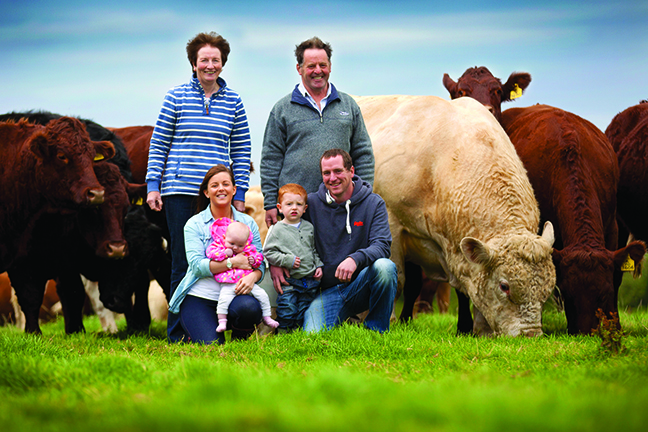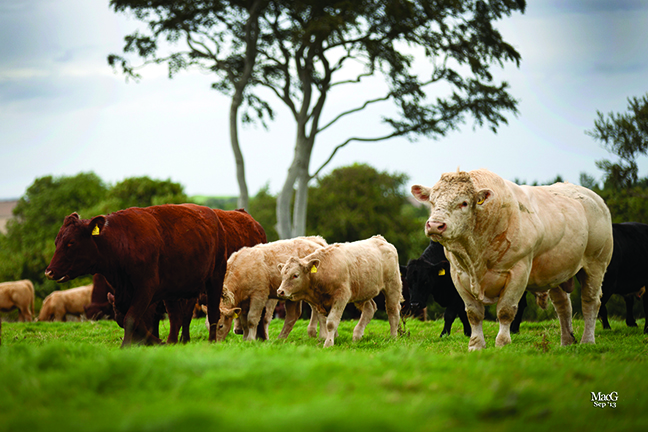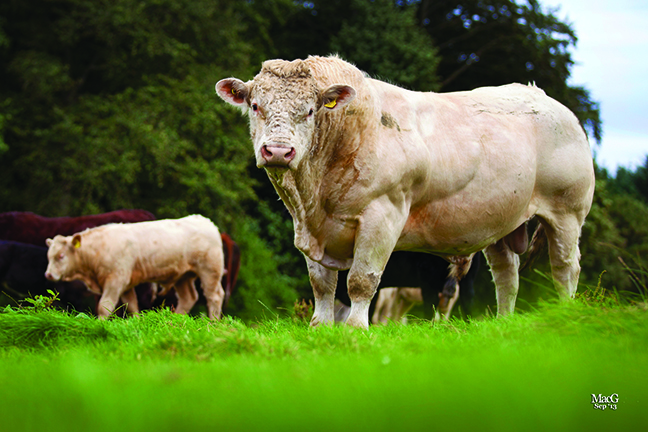The Milne family, Robbie, Barbara and their son, James are among the hundreds of suppliers to one of Scotland’s major processors who are reaping the benefits of finishing Charolais cross cattle within the specification and to target weight faster than any other Continental cross cattle while measuring and monitoring their performance against the company’s monitoring programme.
“Our Charolais cross Salers bulls and heifers are finishing at average heavier weights and faster than processor, McIntosh Donald’s kill of all other crosses,” says Robbie. “For example, our bulls have that performance edge killing out 24 days earlier and 37kg heavier and the heifers followed a similar trend, while 70% of the bulls graded U 2,3L or better and the rest in the R specification. Furthermore, we believe our cattle have the genetic potential for even better performance. There is always room for improvement.”
The Milnes farm at North Bethelnie, Oldmeldrum, Inverurie, a 500 acre mixed LFA unit with additional rented ground. The farm carries a 320 cow split spring calving Salers herd and a complementary 250 ewe flock. “We run a low input unit, yet we are focused on maximising output and subsequent value per unit of body weight from our cows, all of which are put to the Charolais. We also have that critical mass which enables us to spread costs across the herd.
“Apart from heifers retained for replacement purposes, the remainder are finished to 340kg target weight, whilst all our steers have been traditionally sold in Thainstone consistently arrive within the day’s top 10% of store prices. However in an attempt to retain more margin per cow for ourselves, we started to finish the bulls from the early spring calving herd. The exercise proved to be a success and we have sufficient accommodation, so for the first time this season we are finishing the entire crop of male calves as bulls on a mix including homegrown cereals and forage and forward bought peas and potatoes.”
All North Bethelnie finished cattle are sold to McIntosh Donald which offers support with its Qboxanalysis. The monitoring programme provides producers with comparative information on the on-farm performance of their own individual animals against the rest of the company’s kill, and ultimately enables them to make better on-farm management decisions.
The Milne’s Charolais cross bulls are currently finishing at an average 385kg at 420 days, while same way bred heifers are reaching 340kg target weight at 17 months, performance reflecting similar performance, if not better than those same way crosses incorporated in to the Qboxanalysis.
Charolais crosses make up almost 25% of McIntosh Donald’s total kill. These cattle finished at an average 352kgs within 682 days, 22 days earlier and 14kg heavier than the remainder – a mix of Continental cross and native breeds. Those performance benefits are estimated to leave an additional income of more than £132 a head over the remainder, when taking in the current 396p/kg average market price (R4L) and 350p/day costs. See table 1.
Table 1: Finished cattle performance comparison, Charolais crosses v all others
|
All cattle |
Young bulls |
Heifers |
||||
|
Char x |
All others |
Char x |
All others |
Char x |
All others |
|
| Head |
225,948 |
752,156 |
12,594 |
46,097 |
93,803 |
262,787 |
| Ave dwt (kg) |
352 |
338 |
363 |
348 |
314 |
304 |
| Age (days) |
682 |
704 |
438 |
444 |
658 |
685 |
| Grade* |
3.6 |
3.9 |
3.26 |
3.48 |
3.79 |
3.26 |
Source: McIntosh Donald Qboxanalysis
* Grading matrix takes in any figure below 4 as better than R4L
McIntosh Donald’s Murray Gibb explains: “The Qboxanalysis system is providing our suppliers with a quick, easy to access and highly accurate analysis of each animal’s classification for benchmarking purposes, both within their herd and as a performance guide against others. The system encourages farmers to weigh their animals at a younger age, and thereafter more frequently, batch them according to weights rather than age and select more carefully those ready for slaughter. Suckler producers may need to select more carefully their terminal sires while finishers need to review their feeding diets to achieve better weight gain and earlier finishing.”
At North Belnethie, the Qboxanalysis data is examined after each kill. “We manually record every single beast so that we can check their performance, primarily for weight gain, and monitor the trends. While our Charolais bull selection is initially visual – he has to look the part, Breedplan data is essential for us to make a judgement, primarily on 400 day weight and we’ve found that the higher the figures the better the progeny’s performance. In fact the Qboxanalysis has convinced us to invest in bulls within the breed’s top 10% on performance. Any bull or female leaving progeny that underperform is down the road.”
The new finishing regime has also promoted the Milnes to rethink their systems. “Introducing EID and updating our handling system with weigh scales is on the cards and will enable us to monitor individual performance more carefully and fine tune where necessary, and overall further exploit our Charolais crosses genetic potential.”
Categories: Commercial, News
Supreme Charolais on show at the NI National Show in Fintona » « Saxon Charolais peak at 5,000gns



